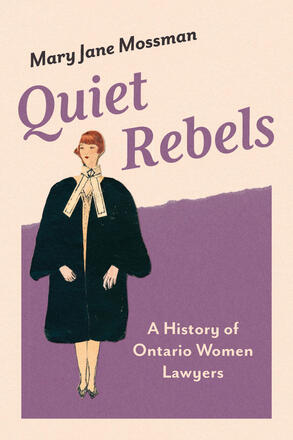
Description
“It’s a girl!” the Ontario press announced, as Canada’s first woman lawyer was called to the Ontario bar in February 1897. Quiet Rebels explores experiences of exclusion among the few women lawyers for the next six decades, and how their experiences continue to shape gender issues in the contemporary legal profession.
Mary Jane Mossman tells the stories of all 187 Ontario women lawyers called to the bar from 1897 to 1957, revealing the legal profession’s gendered patterns. Comprising a small handful of students—or even a single student—at the Law School, women were often ignored, and they faced discrimination in obtaining articling positions and legal employment. Most were Protestant, white, and middle-class, and a minority of Jewish, Catholic, and immigrant women lawyers faced even greater challenges. The book also explores some changes, as well as continuities, for the much larger numbers of Ontario women lawyers in recent decades.
This longitudinal study of women lawyers’ gendered experiences in the profession during six decades of social, economic, and political change in early twentieth-century Ontario identifies factors that created—or foreclosed on—women lawyers’ professional success. The book’s final section explores how some current women lawyers, despite their increased numbers, must remain “quiet rebels” to succeed.
Reviews
This brilliant and innovative ‘group biography’ of pioneering women lawyers in Ontario gives voice to those mostly overlooked women. In doing so, it also sensitively explores the still elusive issues surrounding the relationships between inclusion/diversity and representation/reformulation and asks if what they began was the transformation or merely a slightly altered continuation of the traditional in the legal profession and the practice of law. Highly recommended.
- Martha Albertson Fineman, Robert W. Woodruff Professor of Law and Founding Director of the Feminism and Legal Theory Project and the Vulnerability and the Human Condition Initiative at Emory University
Mary Jane Mossman has produced an extraordinary work of scholarship in excavating the details of the 187 women called to the Ontario Bar between 1897 and 1957, as their lives were formerly entombed in silence. While we are familiar with the resistance of the ‘gentleman’s profession’ towards the entry of women, the struggles undergone by individual women to establish a career are less well known. The wealth of detail in this book relating to the impact of class, race, religion, family connections, as well as marriage and children, augments our knowledge of the sustained history of gender injustice in law.
- Margaret Thornton, Emerita Professor, Australian National University